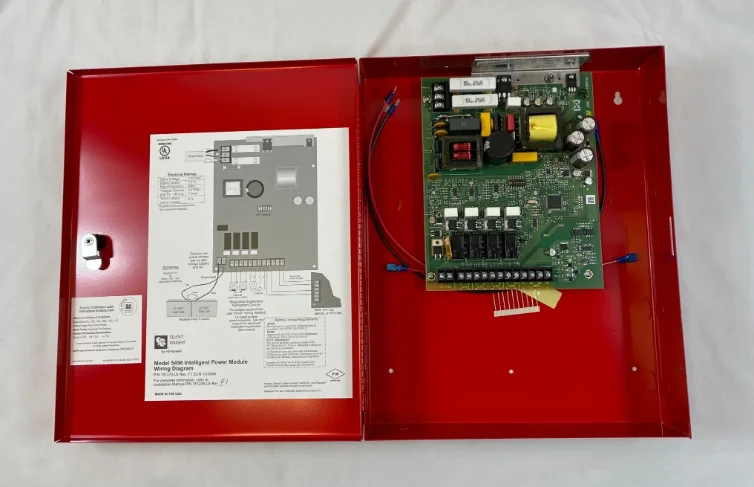
Silent Knight 5395 Distributed Power Module
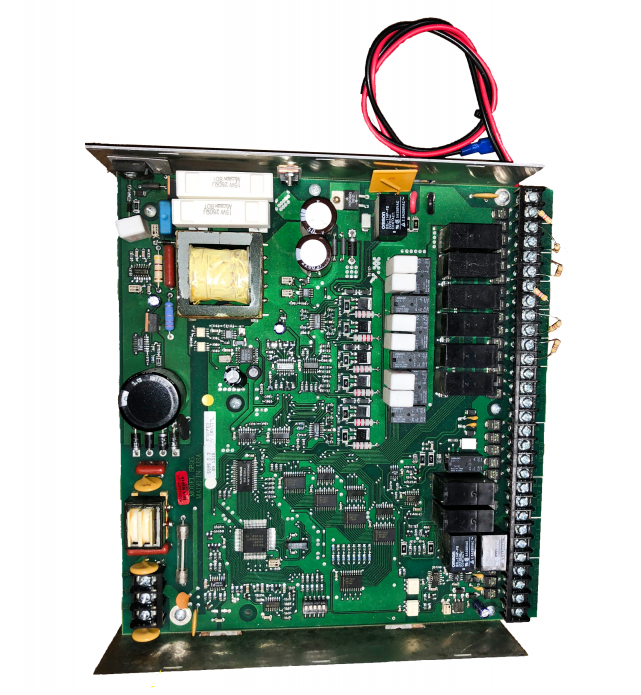
Introduction
The Model 5395 is a notification and auxiliary power expander that provides up to 6 amps of regulated, 24-volt power for powering notification appliances and auxiliary devices. The 5395 provides its own AC power connection, battery charging circuit, and battery connections. Used with security and fire panels, the 5395 enables you to connect and distribute power to many more devices than your panel may normally allow.
- Comparison to the Silent Knight Model 5295
The 5395 signal inputs operate the same way as the signal inputs on the Model 5295 Signal Power Expander. Two of the configurations described on page 5 are the same as the two configurations on the 5295. However, pay close attention to the output and input terminal numbers before replacing a Model 5295 with the Model 5395. The terminal assignments of inputs 1 and 2 are reversed on the 5395, and there are additional terminals on the 5395 that are not on the 5295 panel. - Input Configurations
The 5395 has two optically isolated signaling inputs that provide the signal connection from the main control panel to the 5395 (see page 4 for more details). - Output Configurations
The 5395 has four power-limited notification outputs that can be configured in various combinations of Class A and Class B circuits (see page 5 for more details). - Auxiliary Power Configurations
The 5395 has a dedicated, power-limited, auxiliary output that can be configured in two different ways. The auxiliary output can either be non-resettable (always on) or configured to switch off when the AC power goes off to conserve the battery’s standby power. When the auxiliary power is configured to switch off, there is a 330-second delay before the auxiliary power is turned off after the AC power goes off (see page 19 for more details). - Form C Trouble Relay
The 5395 includes a general trouble relay that will de-energize for any trouble situation on the 5395 (see page 12 for more details). - Earth Fault Detection
The 5395 monitors for earth faults to the system power or system ground. When detected, the system de-energizes the trouble relay and the input supervision relays (see page 28 for details). - ANSI Temporal Code
The 5395 provides two configuration options that will drive outputs with the ANSI temporal code if the inputs are on constant (see page 18 for details).
UL Requirements
When installed in accordance with NFPA 72 rules, the 5395 is listed to meet UL 1481 standards and can be connected to UL-listed devices suitable for local service. The 5395 is also listed to meet UL 864 standards and power limiting requirements.
The 5395 is compatible with any UL-listed control unit utilizing reverse polarity supervised notification outputs, using 24 VDC regulated outputs.
System Overview
CAUTION
Each output circuit is rated at 3 amps. DO NOT OVERLOAD. Overloading a circuit will cause it to shut down (power limit). The circuit will automatically reset once you remove the overload condition.
Terminal Descriptions and Electrical Ratings
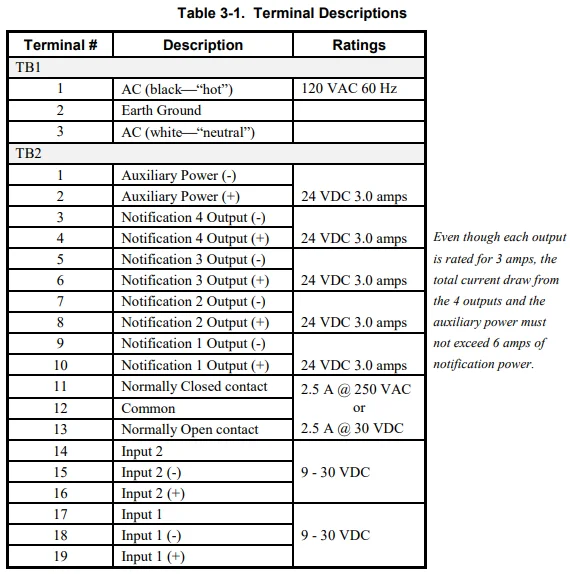
Signal Input Terminals
Terminals 14 through 19 are polarized signal input terminals. They provide the signaling connection from the main panel to the 5395. See Figure 4-2 on page 11 for more details. Section 5 shows connections to specific Silent Knight fire and security panels.
The main panel supervises its notification circuits used for communicating with the 5395 in the same way it supervises ordinary notification circuits. The signal inputs on the 5395 monitor the polarity of the voltage coming from the main panel’s notification circuits to determine when to operate the notification circuits on the 5395. The 5395 emulates the trouble behavior of a normal notification circuit by breaking the EOL supervision current for internal or output trouble conditions on the 5395.
Note that the 5395 will accurately sense the polarity of the main panel’s notification circuits to drive the outputs, whether or not the supervision connection is intact. The following situations will disconnect the EOL supervision at the signal inputs and indicate a trouble condition:
- Low AC power
- Low Battery condition
- Earth ground fault to the system power or system ground
- Auxiliary output power-limited condition
- EOL supervision trouble or a power-limited condition at an output
Trouble conditions will not necessarily occur for both inputs when the trouble is specific to a particular output. Only the signal input controlling the output circuit that is in trouble will indicate a trouble condition. Below are examples where both inputs do NOT indicate trouble for a trouble occurring at only one output circuit.
Example 1: If input 1 controls all four outputs, a fault on any output will cause input 1 to indicate trouble. The fault does not affect input 2.
Example 2: If input 1 controls outputs 1 and 2, and input 2 controls outputs 3 and 4, a fault condition on output 3 or 4 will cause input 2 to indicate trouble. The fault does not affect input 1.
Note: Once the inputs are driven with forward polarity to activate the outputs, the main control panel will not be able to sense trouble conditions through its notification circuit connected to the 5395 input circuits. Use the 5395 trouble relay when it is necessary to monitor trouble conditions and active alarm conditions at the same time.
Section 7 explains the significance of each trouble condition in more detail.
Notification Output Terminals
Terminals 3 through 10 are the notification output terminals. Each of the four outputs is rated at 3 amps, though you can only draw a total of 6 amps from the 5395. The 5395 outputs are short-circuit protected (power-limited) according to UL 864 standards. Overcurrent indicators are yellow LEDs. The output voltage can vary depending on the load and input voltage.
The four power-limited notification outputs can be configured as follows:
- Four class B circuits
- Two class A circuits
- One class A and two class B circuits
- Class B, ANSI temporal-coded circuits
One or both 5395 signal inputs control the notification outputs, depending on the specific configuration setup. Possible configurations for the 5395 are:
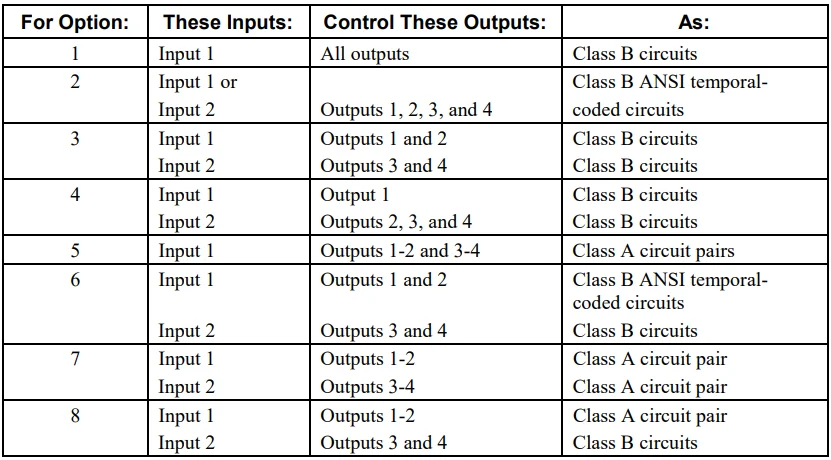
You can select which input controls which output, and which inputs are class A and class B, using the 5-position DIP switch on the printed circuit board. Refer to page 17 for DIP switch settings.
Installation
Before installing the 5395, the AC input must first be wired into the building’s main electrical power through the TB1 terminals (see page 11). Shut off the electrical power to the 5395, and then complete the general installation of the 5395 using the information in this section.
Mounting
Mount the 5395 in locations that meet the following temperature and humidity requirements. Do not expose the 5395 panel to conditions outside of these ranges.

When mounting on interior walls, use appropriate screw anchors in plaster. When mounting on concrete, especially when moisture is expected, first attach a piece of 3/4-inch plywood to the concrete surface. Attach the 5395 to the plywood.
Wire Routing
To avoid induced noise (transfer of electrical energy from one wire to another), keep input wiring isolated from high-current output and power-limited wiring. Induced noise can interfere with telephone communication or even cause false alarms. Avoid pulling one multiconductor cable for the entire system. Instead, separate high current input/output from low current. Separate power-limited from non-power-limited wiring. Non-power-limited wiring must be enclosed in conduit.
Wiring within the cabinet should be routed around the perimeter of the cabinet. It should not cross the printed circuit board, where it could induce noise into the sensitive microelectronics or pick up unwanted RF noise from the switching power supply circuit.
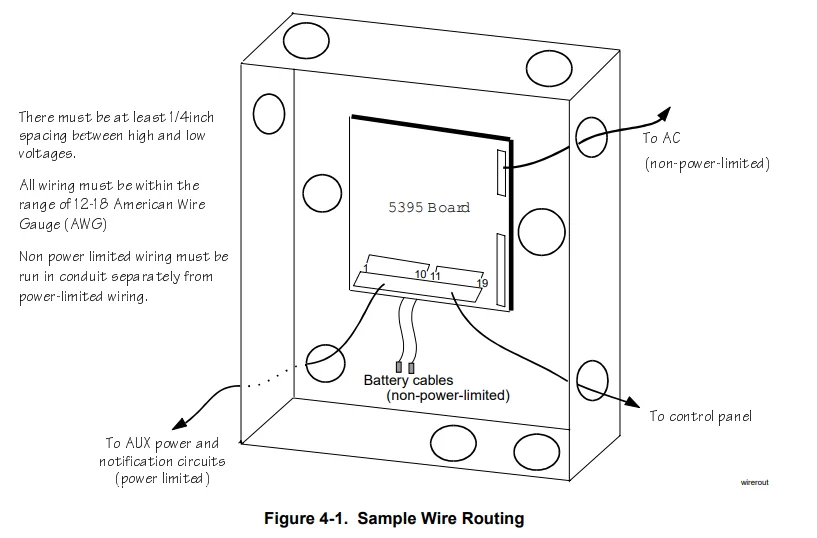
Current Requirements (Standby and Alarm)
Current Drawn From Host Panel
Table 4-1 shows the 5395 current draw requirements from the main control panel when the panel’s notification circuit is in alarm. The current draw from the main panel when it is supervising the 5395 is the same current draw that would be present when the main panel supervises an ordinary notification circuit.

Current Drawn from Battery
Backup batteries used with the 5395 must be UL-listed 7 AH batteries, such as the Silent Knight Model 6712. See page 16 for battery installation.
The following is the maximum current draw from the auxiliary power terminals for standby calculations. These currents assume 24 or 60 hours of standby time followed by 5 minutes of maximum alarm current.
- 195 mA for 24 Hours of Auxiliary Standby Current
- 39 mA for 60 Hours of Auxiliary Standby Current
The above numbers were calculated assuming the use of 7 AH batteries at 100% of rated capacity.
The total current of the 5395, plus all items attached to it, must not exceed 6 A when the panel is in alarm. Use Table 4-2 on page 9 to ensure that the current does not exceed 6 A and that the desired amount of standby is possible for the battery intended to be used with the 5395.

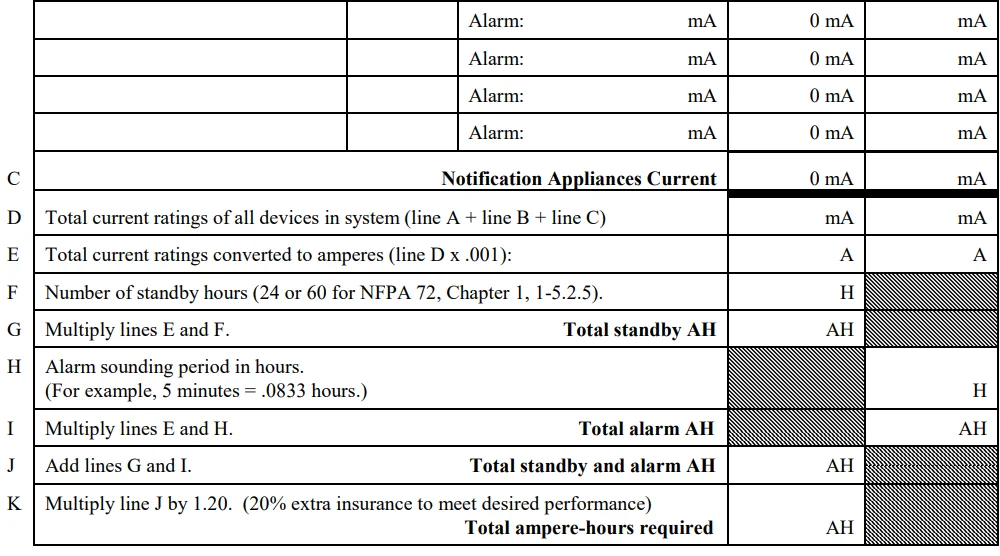
Connecting the 5395 to a Control Panel
Figure 4-2 shows the general layout of the 5395 PC board. This section also provides specific wiring details for accessories.
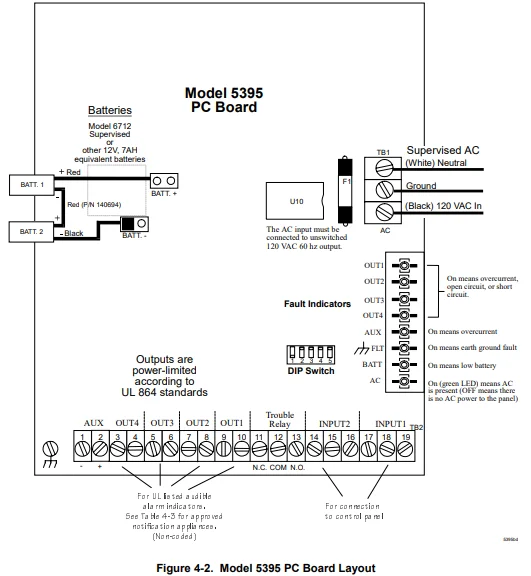
Consult your control panel manual for specific wiring information on the control panel being used. If you are using a Silent Knight control panel, see page 20 for connections.
Trouble Relay
The 5395 board has a Form C trouble relay built into terminals 11-13. The relay provides a normally open and a normally closed contact, both of which are rated at 2.5A. The trouble relay will deactivate under any trouble condition.
A typical application of the trouble relay is to connect the 5395 normally closed (N.C.) contacts in series with the EOL supplied with the fire panel. This will cause trouble on the fire panel when the 5395 opens its trouble contacts.
Note: The N.C. contact is the relay contact that is closed when the 5395 has power and there are no trouble conditions.
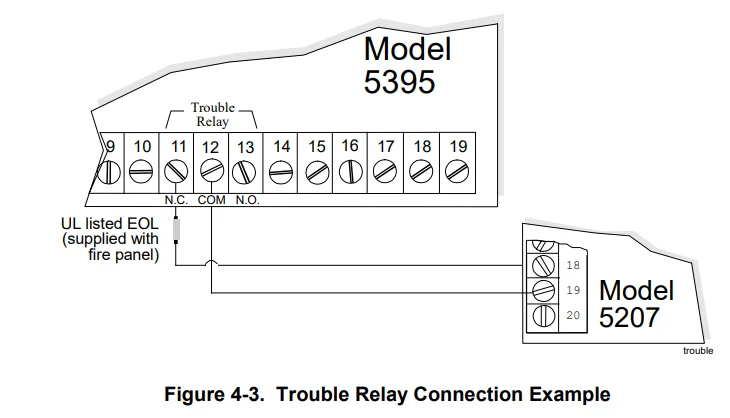
Class A Supervised Wiring
Figure 4-4 shows how to wire for Class A input and output supervision. Use in/out wiring methods for proper supervision. (See page 15 for notification appliances that must be used with the 5395.)
Class A Output Notification Circuits
The configuration shown in Figure 4-4 shows two 3-amp devices wired as class A circuits. When you are using the outputs as class A circuits, loop the wiring back to the corresponding circuit pair. For class A wiring, no external EOL is necessary since it is built into the 5395 board.
Class A Supervised Input Circuits
The configuration shown in Figure 4-4 shows class A supervised wiring from a fire panel to the Model 5395 board. Pay close attention to the polarities when wiring a panel to the 5395 and follow these requirements:
- When wiring to terminal 18 on the 5395, you must use two separate wires. Do not loop a single wire or twist two conductor wires together.
- Do not use notification appliances on class A circuits connected to a 5395 for input. The 5395 will detect voltage across the input circuits, but is not designed to pass the added current load from notification appliances.
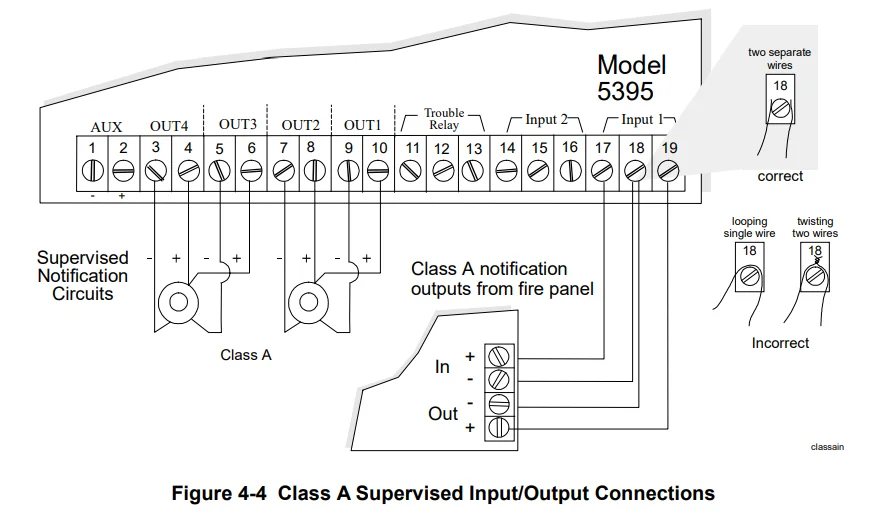
Class B Supervised Wiring
Figure 4-5 shows how to wire for Class B input and output supervision. Use in/out wiring methods for proper supervision. (See page 15 for notification appliances that can be used with the 5395.)
Class B Output Notification Circuits
Figure 4-5 shows four 1.1.5-ampevices wired as class B circuits. Place a 4.7k ohm EOL resistor (provided) at the end of each loop to enable notification output supervision when using all outputs as class B notification circuits. The 4.7k EOLs must be wired to the terminals, whether or not you are using all output terminals.
Class B Supervised Input Circuits
Figure 4-5 shows class B supervised wiring from a fire panel to the Model 5395 board. Use an EOL resistor as shown to enable notification input supervision. Some panels use EOLs that have a different value than the 4.7k ohm EOL resistor used by the 5395. In this case, the EOL must be UL listed for the fire panel (not the 5395).
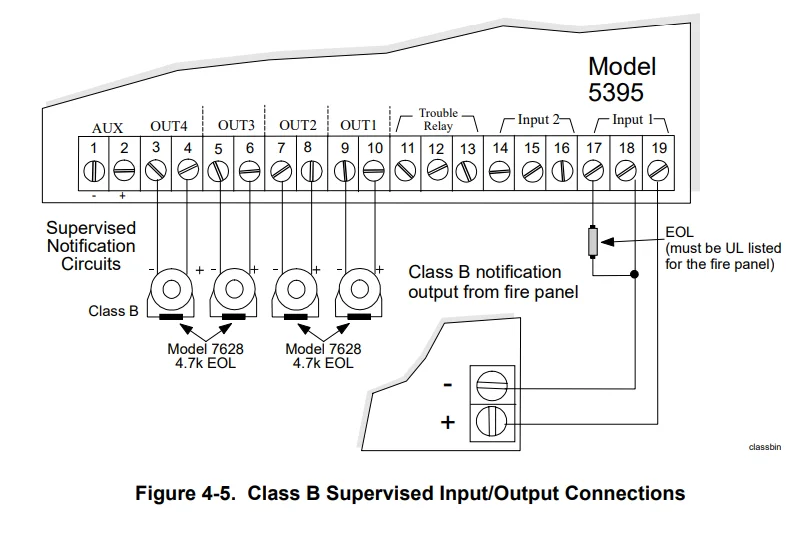
Battery Connection
You must use two backup batteries with the 5395. Use 12 VDC, 7 AH gel cell batteries, such as the Silent Knight Model 6712. It is recommended that you replace the batteries every five years.
The following steps and diagram explain how to connect the batteries.
- Connect the black wire to the negative (-) side of battery #2.
- Connect the jumper wire provided (P/N 140694) from the positive (+) side of battery #2 to the negative side of battery #1.
- Connect the red wire to the positive (+) side of battery #1.
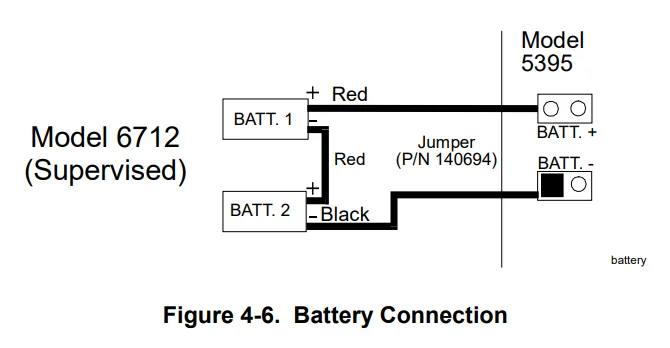
DIP Switch Settings
A 5-position DIP switch on the 5395 board allows you to select the following:
- How long will the 5395 wait before indicating a loss of AC?
- Which input (Input 1 or Input 2) will control the notification outputs?
- Which outputs to wire as class A and class B?
- Auxiliary power state.
- Which outputs operate as steady outputs or ANSI temporal?
Refer to Figure 4-2 on page 11 for the location of the DIP switch on the 5395 board.
Selecting the Input/Output Configuration
Figure 4-7 shows the position of each switch on the DIP switch for various input and output configurations. The positions of switches 4 and 5 do not affect the relationship of inputs to outputs.
Note: The 5395 checks switches 1, 2, and 3 only when powering up the 5395. If you change these switch settings, you must remove both the AC power and the battery to force the 5395 to recognize the new switch settings.
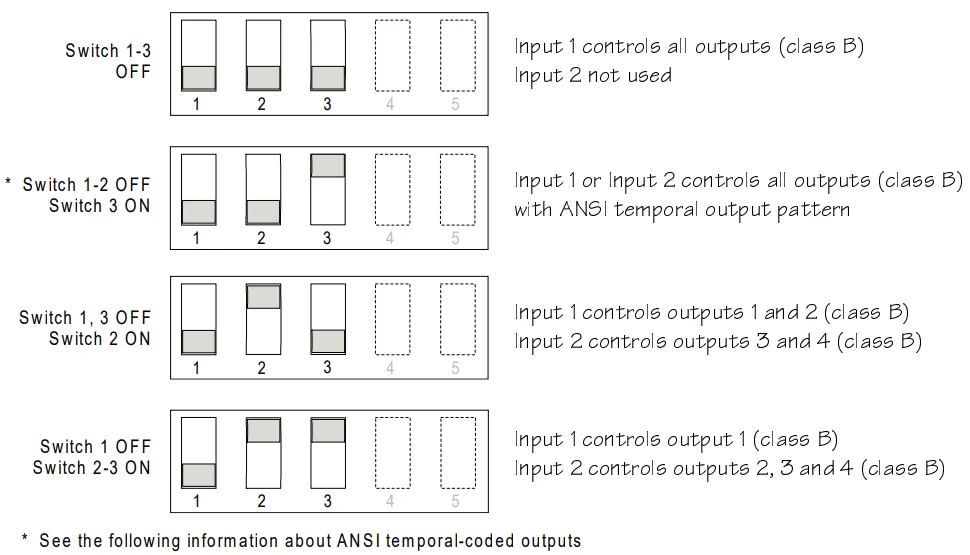
Model 5395 Distributed Power Module
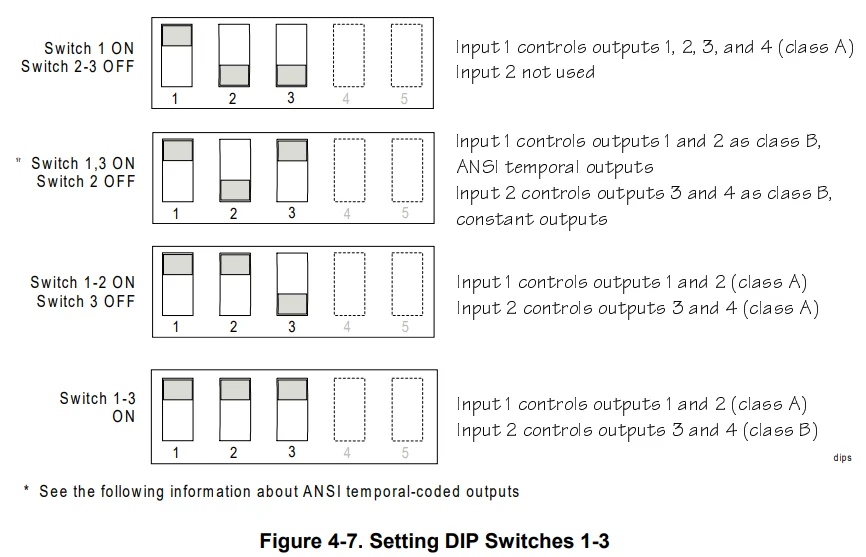
Special Note for Input/Output Configurations That Select ANSI Temporal-Coded Outputs
The DIP switch settings marked with an asterisk (*) in Figure 4-7 are designed to produce ANSI temporal-coded outputs from a constant on input. The figures shown below compare the output patterns of configurations before and after the addition of this feature.
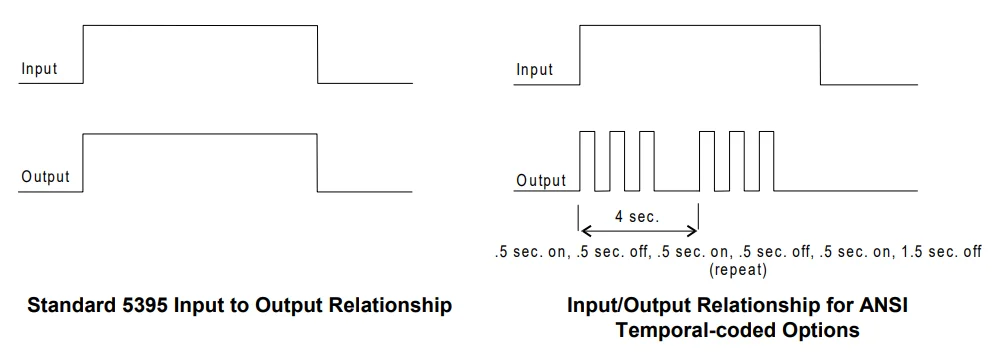
With this new feature, a steady signal can produce the pattern shown above for panels not previously able to do so.
Note: The 5395 can also produce other temporal patterns if the patterns appear at the inputs for the non-ANSI temporal configurations.
Setting the Loss of AC Delay
Normal selection for reporting loss of AC is 6 hours.
The ON position is for test purposes only, and the normal position for switch 4 is OFF. For testing the Low AC reporting, you can temporarily turn switch 4 ON without removing power. Remember to turn the switch OFF when testing is complete.
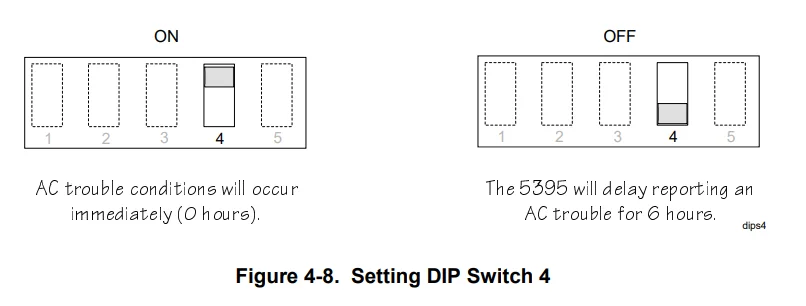
Setting the Auxiliary Output
Switch 5 on the DIP switch determines how the auxiliary power operates on the 5395. The 5395 checks switch 5 only when powering up the 5395. If you change this switch, you must remove both the AC power and the battery to force the 5395 to recognize the new switch setting.
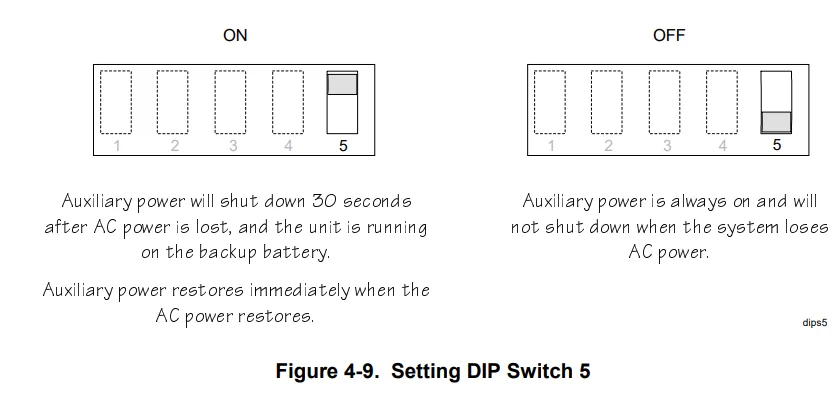
Connection to Silent Knight Panels
The drawings in this section show you how to connect the 5395 to compatible Silent Knight panels. See panel installation manuals for more information.
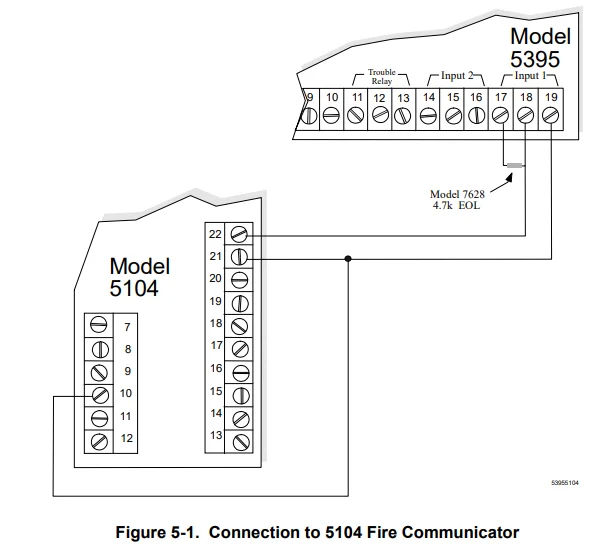
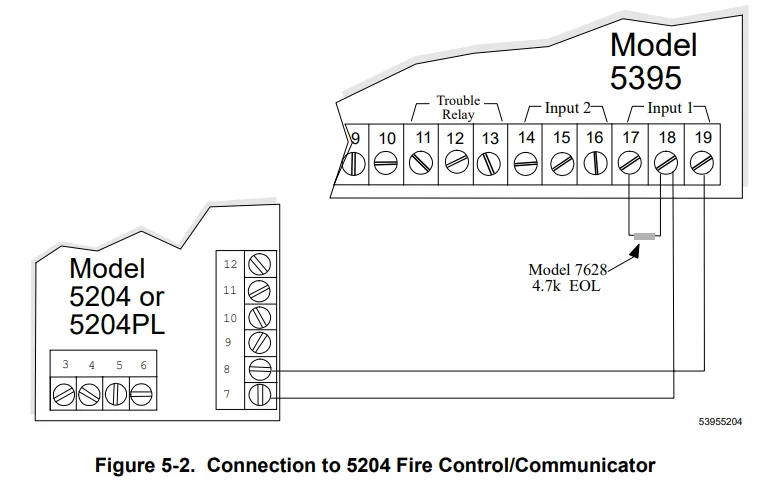
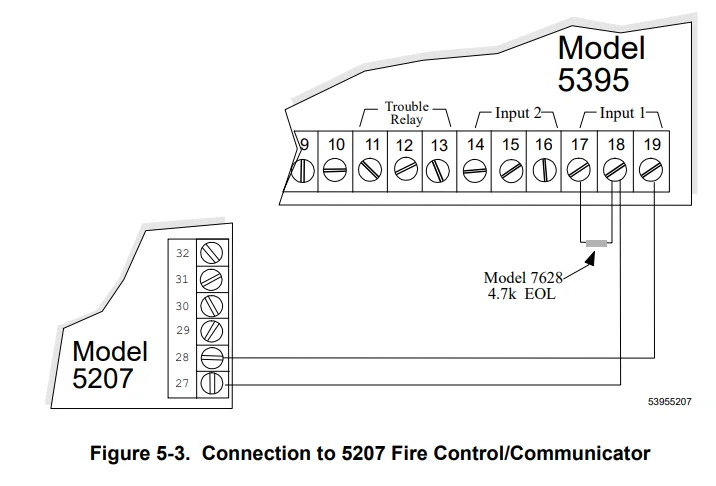
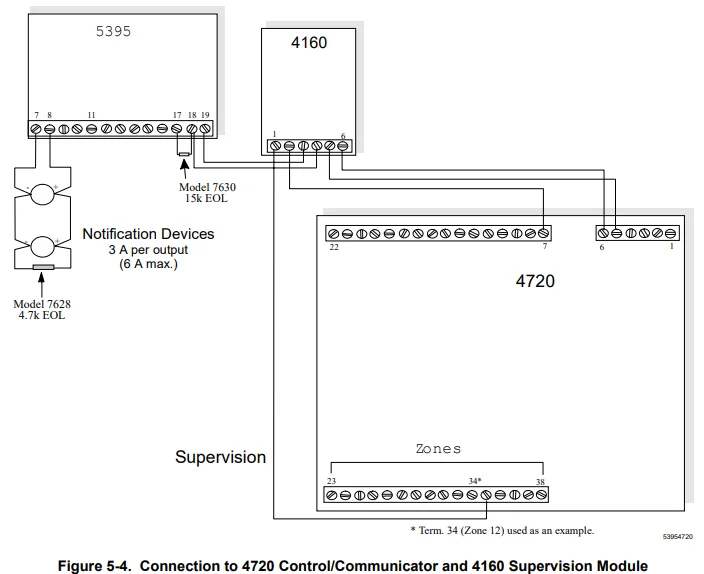
Sample Applications
The drawings in this section show various 5395 configurations, including daisy-chaining.
Notification Power Applications
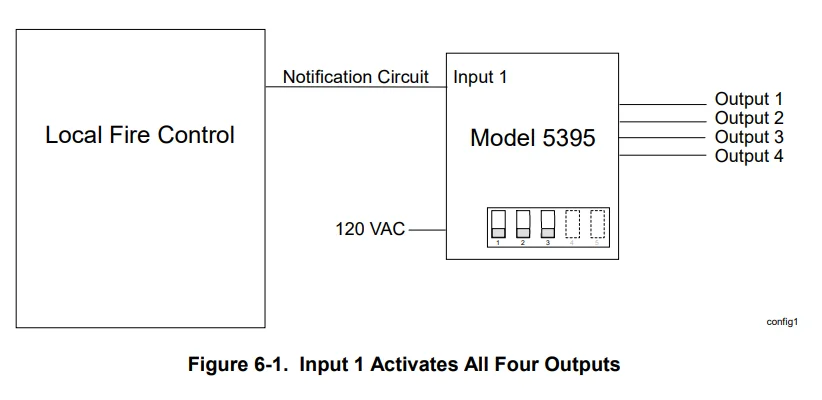
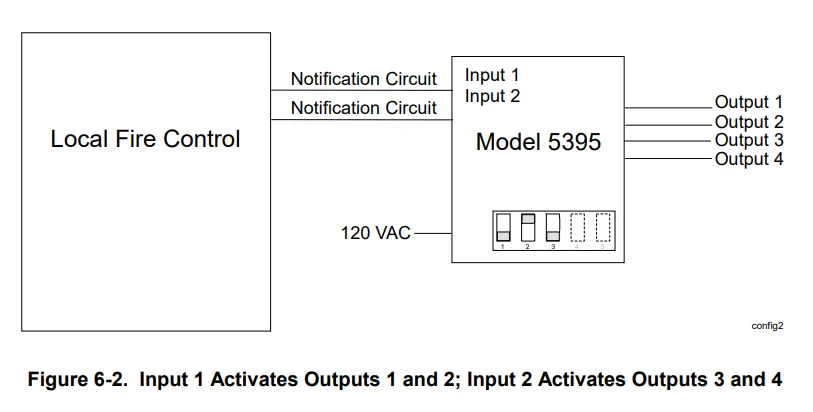
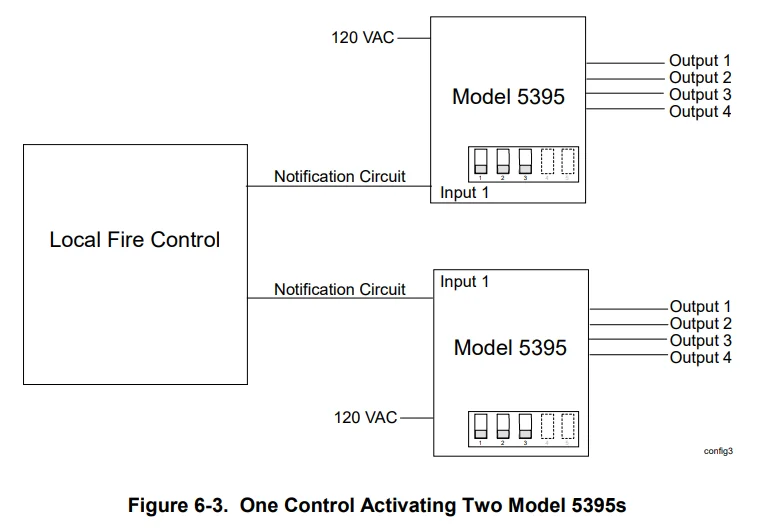
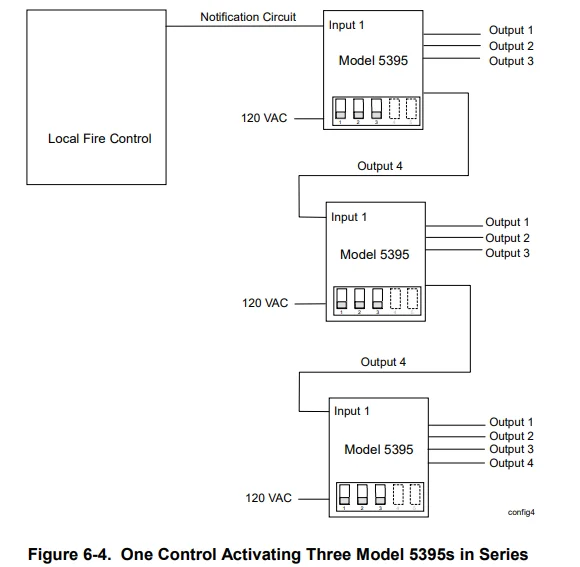
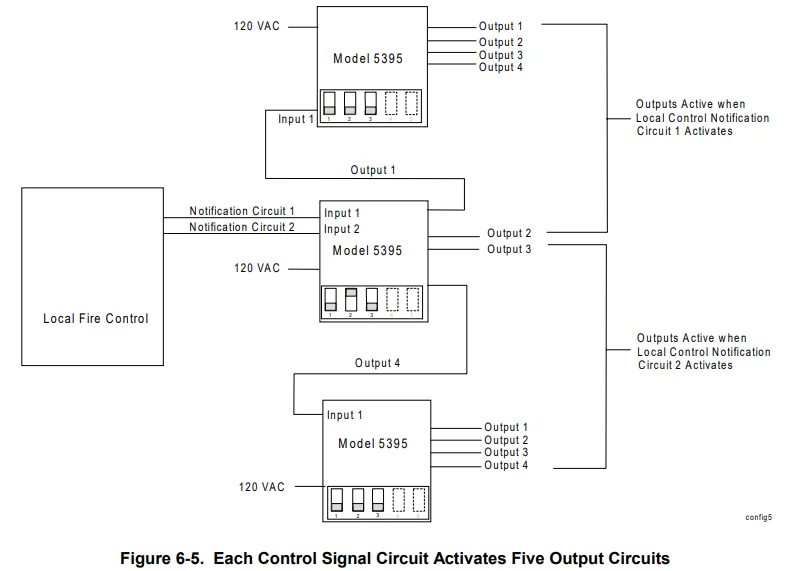
Non-Resettable Power Application
The 5395 provides a dedicated 3-amp auxiliary power output that you can select as non-resettable (output is always on). See Section 4.7.3 for setting the auxiliary power. If you need more than 3 amps, wire the inputs as shown in Figure 6-6.

Door Holder Application
In a typical door holder application, the door holder power must be released to close all fire doors under the following conditions:
- Any active alarm condition.
- AC power is no longer present (to conserve backup battery power).
To close the fire doors in these situations, wire an N.C. programmable relay from the fire panel in series with the auxiliary power to the door holders as shown in Figure 6-7. The circuit shown in Figure 6-7 will provide up to 3 amps of door holder power. (See Section 6.2 if you need more than 3 amps of auxiliary power.) The power in this example is released when AC power is off for 30 seconds or more, or when the relay from the fire panel becomes open.
You would have to use the equivalent of a programmable relay from a fire panel that is programmed to open under alarm conditions. See page 19 for selecting auxiliary power options.

Troubleshooting
Light-emitting diodes (LEDs) indicate fault conditions. This section describes the LED states and provides trouble condition details.
LEDs
The eight LEDs indicate a fault condition in one of the circuits (either outputs 1 through 4, auxiliary power, earth fault, low AC, or battery). A fault condition in the LED’s corresponding circuit will turn on the LED (labeled on the board). Their functions are as follows:
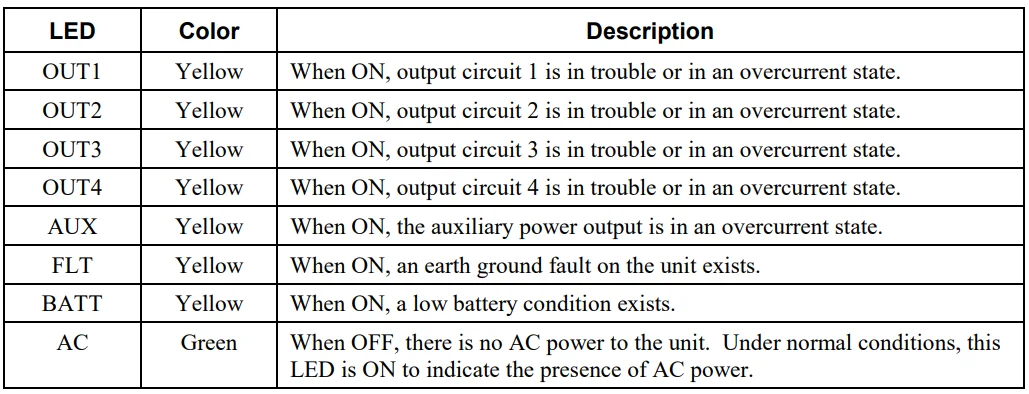
See page 11 for locations of LEDs.
Trouble Conditions
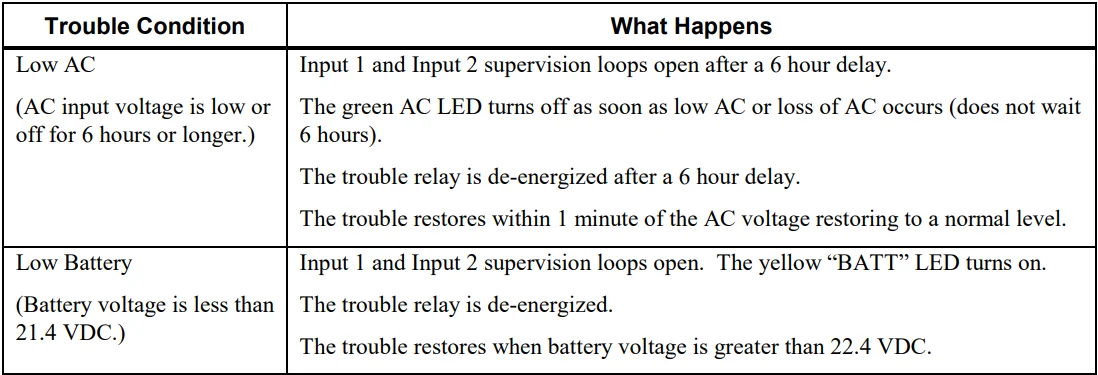
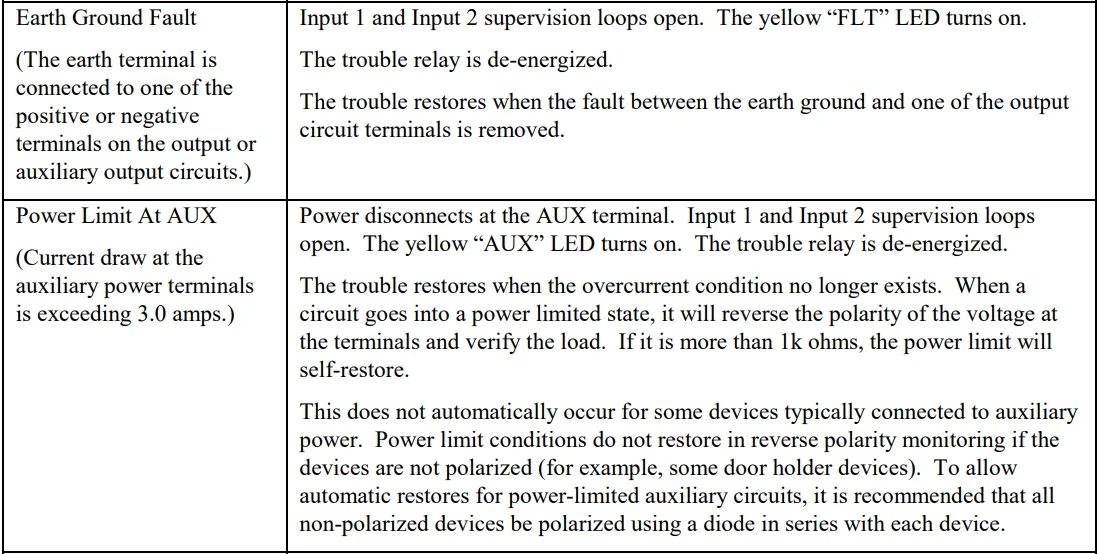

For more manuals by Silent Knight, visit ManualsLibraryy
Silent Knight 5395 Distributed Power Module- FAQs
2. What does the Silent Knight 5395 do?
The 5395 supplies power to notification circuits, auxiliary devices, and provides battery backup. It can be activated by NAC inputs from a control panel and automatically switches to backup batteries during power loss.
3. How much output current does the Silent Knight 5395 provide?
The module offers up to 6 amps of regulated 24 VDC power, distributed across multiple outputs to power horns, strobes, and other fire alarm devices.
4. What kind of power source does the 5395 use?
It connects to an AC power source and includes a built-in battery charger for maintaining standby batteries that supply backup power in case of AC failure.
5. Can the 5395 be used with other Silent Knight systems?
Yes. The 5395 is fully compatible with several Silent Knight control panels and can be synchronized with other notification circuits for seamless operation.
6. What is the difference between the Silent Knight 5395 and 5499 models?
While both serve as power expanders, the 5499 delivers 9 amps of power output, whereas the 5395 provides 6 amps. Both include their own AC input, charging circuit, and battery backup features.
7. What indicators are available on the 5395 module?
The unit includes LED indicators that display AC power status, battery condition, and trouble signals, allowing easy system monitoring and troubleshooting.
8. How does the 5395 handle system faults?
If AC fails, batteries are automatically engaged. The system also reports faults such as low battery or ground fault back to the main control panel.
9. What type of batteries does the Silent Knight 5395 use?
It typically supports sealed lead-acid batteries, with a maximum capacity recommended by Silent Knight to ensure proper standby duration.
10. Where should the Silent Knight 5395 be installed?
The module should be installed indoors, in a dry location, close to the main fire alarm control panel, following all local electrical and fire safety codes.

